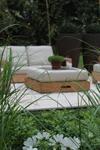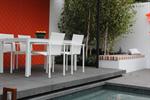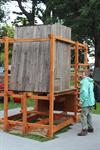
What could be better than to become part of the garden, by extending your living area into it?
By selectively using outdoor furniture you can create a new room for your home
THE GARDEN ROOM
There are many pieces of furniture that are commercially produced for using in the garden. What you choose is a personal preference, but some materials are better developed for a harsh climate than others.
LOCATION
If it's going to be used properly, garden furniture needs to be put in the right place. A bbq, table and chairs needs to be protected from the wind, and preferably where there will be some shade at that time of day when they are used. If you like sitting and reading in the garden, put a seat somewhere that will be warm but not hot, and sheltered from wind and noise (not beside your neighbour's teenage son's bedroom!). Play equipment for children should be placed where it can be seen by mum.
GARDEN SEATS AND SETTINGS
One of the rewards of a successful garden is the chance to sit and enjoy nature. Today you have a seemingly infinite choice in seating, with or without tables.
You need to consider a number of things when selecting your garden settings. These include;
- The appearance of the setting does it suit the style of the garden?
- Is the setting comfortable?
- How portable is the setting?
- How safe is the setting?
- What is the lifespan and durability of the setting?
- What maintenance is required?
- What is the cost?
Appearance
Choose furniture which looks right in your garden. Obviously fancy old world lacework on a wrought iron seat looks better in a period or cottage garden than very "modern" or "rustic bush" gardens. As with indoor furniture, your outdoor furniture looks better if it is all the same style and colour, and if the colour complements the colour of the paving or timber it is placed on. Wood furniture often looks better on timber decking or amongst plants, lawn or gravel than on a formal tiled patio.
Comfort
Different materials are more comfortable in different situations. Metal can get very hot or cold in extreme weather. Be sure there are no sharp or jagged edges on any metal furnishings you buy. Some metal seats (particularly with a lumpy decorative base) can become uncomfortable after a while.
Wood can have splinters unless finished off properly. The height of a seat off the ground, the depth of the part you sit on and the amount of back support all affect comfort. Arm rests make a seat more comfortable. Softer materials (eg. Wood and some plastics) are easier to sit on for a long period.
Plastic seats can sometimes become very sticky causing you to sweat. There needs to be ample ventilation (ie. holes or slats) around the parts of the body which are in contact with the furniture. Cushions are often a good idea on hard seats, but you might need somewhere to store them when not in use.
There needs to be an appropriate relationship between the height of a table and the height of a seat. There is nothing worse than eating at a table and having to reach up or bend down to get the food. Sit on both the seat and table before buying. Heavier tables tend to be more stable, while light weight tables often shake every time someone sits down causing drinks or food to fly everywhere.
 Portability
Portability
Do you want seats as permanent fixtures in the garden, or will you store them away when not in use. Any garden furniture which is moved about needs to be able to withstand moving about. Sometimes seemingly well designed portable furniture will develop weak spots when they frequently moved, and eventually parts break off. If you do intend to move furniture about, make sure it is strongly built, not too heavy or awkward to move, and that you have somewhere to store it.
Lifespan and Durability
Pine furniture will often only last a few years out in the weather even if painted with a timber preservative. Treated pine has preservative impregnated deeper than simple painting will achieve, and will last much longer; however pine is not as strong as some timbers. Furniture made from naturally durable timber such as red gum, merbau or jarrah will last a lifetime and beyond if treated well.
Some plastics will last much longer than others. Generally you get what you pay for. Expensive plastic or fibreglass furniture will last for decades even if left out in the weather. Cheaper plastic furniture tends to become brittle or break through exposure to UV light and wear and tear much sooner.
The durability of metal furniture also varies greatly. In coastal areas galvanized iron or cast iron will rust much faster. Some metals (eg. stainless steel and aluminium) resist corrosion.
Maintenance Required
Timber needs to be checked regularly (at least annually) for developing wood rots and any splinters. Smooth off rough parts with a file or wood plane and sandpaper. Treat any soft parts of timber with preservative. Spray any ants which appear on timber.
Cheaper plastic seats are probably best kept out of direct sunlight as much as possible from day 1. If plastic seats are becoming brittle or developing cracks, they should be replaced before they become a safety problem.
Preserve timber and metal with regular painting or staining, and treat corrosion (eg. rust) as soon as detected.
Some furniture incorporates soft material such as canvas into the construction (eg. directors chairs, deck chairs, cushions etc). If you have a chlorinated pool, you may find chlorine in the water can cause colours to bleach out of material. Colour in material and some plastics can also fade if exposed to strong sunlight.
Cost
With garden furniture you tend to get what you pay for. Less expensive
furniture is often more expensive to maintain, or needs to be replaced sooner. More expensive furniture often resists weathering better, hence you avoid the regular job of moving it out of the weather.
BBQ's
BBQ's bring the kitchen into the backyard. They eliminate the problem of guests dropping food on the carpets, and they allow the cook to be with the guests outside while preparing the food.
Whether your preference is wood, gas, electric or heat bead, there will always be room made for BBQ's. Some may choose permanent structures, others portable.
STATUES AND FIGURINES
A well placed statue or figurine can add a sparkle of surprise to anyone walking through your garden. They can also be used to give the garden a theme (eg. Stone lanterns in Japanese Gardens).
Like other garden furniture, statues can be made from different materials.
Statues are often concrete. These are heavy and less likely to be blown over by wind or pushed by animals or children. Subjects are most frequently people or animals.
Stone statues are liked by many people for giving a sense of agelessness. Usually very expensive, it is solid, but will last forever. If you have natural rock formations in your garden or area try to utilise the same type of rock. This way the statue will complement the garden. Subjects are often humans or stylistic.
Metal can give a dramatic contrast to the garden. Ensure that it will not tarnish or has been treated, unless you want it to. Care should be taken of sharp or jagged edges.
LIGHTS AND LIGHTING
Garden lights both improve security of your property, extend the use of the garden into night, as well as highlighting certain sections of the garden.
Lights strategically placed can brighten up a path, sitting area, feature, provide a colour spectacle or even a sense of security.
Garden lights come powered by electricity (usually low voltage supplied by a transformer), battery or solar power.
All lights however will eventually need bulb replacements.
Electric Garden Lights
When planning with electric lights, consider the cost involved, length of underground wiring, appearance of the light itself, illumination strength and number of lighting units required.
Small jobs can be done by the home gardener by purchasing one of the many garden packs available at garden stores. Larger jobs however may require professional installation and council approval.
Always keep records or plans of underground wires and pipes. There would be nothing more dangerous than a spade going through a live wire. Most small garden packs run on small voltages that are not dangerous to humans, however it is still best to be safe than sorry.
Automatic timing switches can be connected so that they turn on and off at specific times. Motion sensitive lights are also beneficial giving a theatrical display as you walk through the garden or as an aid to security.
Battery Lights
Not that common due to the expensive requirement for batteries. They still may have a use in your garden. Each unit runs independent of the next. For this reason they can be placed virtually anywhere without the need of expensive connecting powered lines. Be careful with battery acid leaking into the light unit.
Solar Lights
Relatively new in the garden field, these lights can be placed anywhere, are recharged by the sun therefor running costs are cheap, can provide light up to 12 hours, can be moved easily and in the long run can be cost effective.
They are however a bit expensive initially and the solar cells can be damaged by hail, rocks, sticks, etc.
UMBRELLAS
Provide a bit of extra shade when sitting at the table in the yard by opening an umbrella. Thatching, plastic or material all provide shade, however some are more durable and some suit your garden design better than others. Once again the choice is yours.
In windy weather, detachable umbrellas allow you to readily remove you umbrella to prevent damage.
A weighted base provides stability and eliminates most breeze movement.
Covers are now made to give a dual purpose to that ever present eyesore: the clothes line. These days it can be crowned with an array of colours, while providing a pleasant shaded area to sit under on sunny days.
HAMMOCKS
Wanted: Two sturdy strong trees for support of hammock.
Just about everybody would like a hammock suspended in the shade between two trees. It is relaxing and can provide an ideal spot for sleeping, reading, resting or just watching the world go by.
It is essential that the trees used are mature. Secure the hammock to the tree so that it will not fall when you hop on and so that it does not damage the tree. Protect the tree with a guard of some kind so that the hammock rope does not cut into the trunk. As an alternative permanent timber or metal pipe "hammock poles" can be concreted into the ground, or a base fixed permanently in the ground so that upright poles (stored away when not in use) can be slid into a fixed position to provide anchorage points for the hammock. One end of a hammock could also be fixed to a garden shed, gazebo, etc.
Hammocks are usually made of material. Some are more resilient than others.
The more exposed to the weather it is, the shorter its life will be. Before jumping into that old hammock of yours, check its strength.
 CHILDREN'S PLAY EQUIPMENT
CHILDREN'S PLAY EQUIPMENT
Development of the child both mentally and physically starts at home. If the child is allowed to explore his surroundings and play in it, he will develop a better mental and creative mind than his house bound friend next door. The garden is very often the first educational system a child comes into contact with.
Sand pits: These are often the first play pens of a child. Ensure that it is sturdy, does not hold water, has a cover to displace rainfall and prevent animals contaminating sand, and has protection from the hot sun.
Consider when building the pit to put a layer of gravel beneath the sand to discourage children from digging into the soil and mixing earth with the sand.
Swing Sets and Climbing Units:
These play equipment pieces are made of timber, metal or plastic (PVC) with the occasional piece of rope or chain. Ensure all edges are rounded and smooth, pieces do not come off, it is relatively child safe (nothing is actually 100% child safe), it is visible from your house and it is ideally positioned near shade.
Cubby houses:
This is the pinnacle of childrens garden furniture. This is covered in another section of this magazine.
All play areas must pass your safety standards. Look for sites that might harbour spiders and snakes and avoid those sites or equipment. Children's play is most creative when the child feels they are alone and out of sight of parents. However, common sense says that a young child should always be kept in view for safety reasons. How you wish to meet these two contradicting designing values is up to you. Good creative designing on your part will find an answer.
More from ACS
Ebook - Inspiring: covers formal, natural, eclectic, modern, oriental, Mediterranean; zoom in on stunning images and plans.
View eBook
Ebook - Explores garden design ideas and inspires
garden design and landscaping!
View eBook
Enhance your design skills and apply them to various garden styles.
View Course
Learn to bring together children's play needs and garden design.
View Course
Ebook - Relationships between PLAY and the ENVIRONMENT and how to best utilise this in designing a play area.
View eBook
Course - for landscape consultants, garden designers, horticultural advisors, project managers, or anyone else who works with landscapes and needs to improve their landscaping ability.
View Course